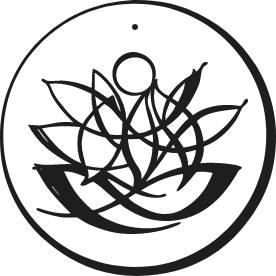Samasthiti or Balanced Awareness
Samasthiti (balanced awareness pose) is the basis of all standing postures—and it’s also the foundation for great posture in everyday life!
Stand with your feet together, feeling six points of balance: under the heels, behind the big toes, and behind the last two toes. Notice how gravity constantly pulls us downward toward the earth, while our energy holds us up. This push-and-pull is a sensation that is ever present. We acknowledge this polarity and encourage it by lifting ever upward.
Feel the energy being drawn from the earth through your feet. Lift this energy through your lower legs, upper legs, over the buttocks, and through your center. Notice that your center is comprised of the two lower bandhas: mula bandha and uddiyana bandha.
Mula bandha is located at (and is) the pelvic floor. These are the muscles you’d lift and hold when you need to go to the bathroom badly! When engaging mula bandha, both sexes feel the sphincter lifting, with females feeling the vaginal cavity and males feeling the scrotum as well.
As you move up through mula bandha, you’ll begin to feel the abdominals and psoas (the muscles at the front of the spinal column) start lifting. This is uddiyana bandha. Engaging this should feel as if you’re lifting your belly button from deep inside.
Don’t forget to breathe—deep ujjayi!
These two bandhas—our center—lift on the inhalation. While we feel the sensation of physical lowering on the exhalation, our energy lifts up. As you move, don’t fall on your center! Once you do, gravity begins to take over—we’re literally weighed down by our own physical mass.
Additionally, as you engage the bandhas, do not grip, scrunch, or bear down. Rather, lift into them; think “soft and strong.” Notice a soft strength beginning at your center and expanding ever outward, radiating all the way through and past your fingertips, the tips of your toes, and even the strands of your hair!
Feel all 24 vertebrae lifting, stacking each on top of the one prior. Your spine is a long, gradual double “s” curve. Do not emphasize these curves! Breathe into the space between each vertebra to create even more space. Feel your ribcage lifting and opening.
Next, feel your collarbones reaching wide to meet your shoulders. Check that your shoulders do not tilt forward or hunch up. If your shoulders roll forward, you create stress—let’s avoid that.
Notice your arms extending down from your shoulders while your hands rotate out. The bends in your elbows and wrists, along with your palms, should all face forward. Position your chin as though it were propped on a shelf, neither tilted up nor down. Feel as if your head were floating above the spine as opposed to sitting on it. Remember: our energy holds us up!
With your eyes wide open, focus directly on a point right in front of you. This is your dristi.
Stand in this posture and breathe ujjayi for a minute or so, and then continue with your practice.
As you practice, remember that samasthiti is the foundation for all standing poses. We change the shape of the body, but we do not let go of how the energy moves through us and how we use the bandhas to support and protect. In our Yoga practice and throughout our day, every move begins at our center and with the breath.
See you on the mat!

